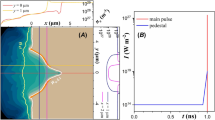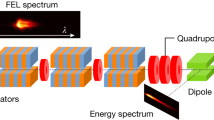Abstract
The Korea Atomic Energy Research Institute (KAERI) has used a microtron accelerator based on a thermionic cathode for operating a compact terahertz (THz) FEL, where the electrons are emitted and accelerated automatically during the radio-frequency (RF) macro-pulse over threshold power for their emission. Usually a thermionic cathode is embedded inside the microtron cavity for electron-beam emission, and at the same time acceleration is due to the input RF source. In this case, the accelerator scheme is simple, but just a fraction of the emitted electrons are accelerated, and the electron bunch length is uncontrollable due to the RF phase condition for acceleration. In this paper, a photocathode-based microtron which is able to produce high peak (∼100 A) and ultrashort (∼1 ps) electron bunch is studied to adapt it for an electron injector of a THz generator. Especially, we analyzed the electron beam dynamics along the accelerating trajectory with a 3D PIC-code to find the optimized RF phase and laser input time.
Similar content being viewed by others
Change history
21 October 2017
One affiliation of Sunjeong Park was omitted. It should be added as “Department of Physics, Kyungpook National University, Daegu 702-701, Korea”. Affiliation of Eun-San Kim had a typo. It should be corrected as “Department of Physics, Kyungpook National University, Daegu 702-701, Korea”.
References
G. L. Carr et al., Nature 420, 14 (2002).
N. A. Vinokurov and Y. U. Jeong, Phys. Rev. Lett. 110, 064205 (2013).
Y. U. Jeong et al., J. Korean Phys. Soc. 59, 3251 (2011).
J. Lee et al., Nucl. Instrum. Methods Phys. Res. A 407, 161 (1998).
G. M. Kazakevitch et al., Phys. Res. A 12, 040701 (2009).
C. S. T. Particle Studio, 2008 CST - Computer Simulation Technology (Wellesley Hills, Ma, USA), www.cst.com.
S. P. Kapitza and V. N. Melekhin, The microtron (Harwood Academic, London, 1978), p. 3.
A. P. Gringerg, Soviet Physics Uspekhi 4, 857 (1962).
J. C. Jimenez, Master thesis, Naval Postgraduate School, 2010.
S. G. Anderson et al., Phys. Res. A 8, 014401 (2005).
M. Ferrario et al., Phys. Rev. Lett. 104, 054801 (2010).
W. J. Veksler, Dokl. Ak. Nauk., J. Phys. USSR. 9, 153 (1945).
E. M. McMillan, Phys. Rev. 68, 43 (1945).
Author information
Authors and Affiliations
Corresponding author
Additional information
An erratum to this article is available at https://doi.org/10.3938/jkps.71.591.
Rights and permissions
About this article
Cite this article
Park, S., Jeong, Y.U., Park, S.H. et al. Simulation on a photocathode-based microtron using a 3D PIC code. Journal of the Korean Physical Society 66, 358–363 (2015). https://doi.org/10.3938/jkps.66.358
Received:
Accepted:
Published:
Issue Date:
DOI: https://doi.org/10.3938/jkps.66.358




